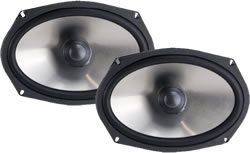Diamond D3 D393i
Beautifully put together, like all Diamond Audio speakers, these were one of only two in our group to sport Allen headed speaker terminals. The chassis is an injection moulded composite casting which is inert and very solid and is also part of the higher than average cost of the set. A two-way design, the tweeters are pole mounted and can rotate and swivel a tad so that you can point them in a wide variety of directions. They are an Aluminium metal dome type and have the magnetic liquid called Ferrofluid hanging in their voice coil gap, which makes them unique in this group I think. This takes the heat from the coil and conducts it away to the body of the magnet so it acts as a heatsink. Thus power handling and linearity are dramatically improved as well as reducing what’s called Power Compression. That’s when the extra heat caused by high power changes the coil’s impedance, raising it so that the power is reduced or compressed on peaks. You don’t hear it much but the lack of it is where real hifi lies. The metal mesh grilles are a good bit better looking than all the other simple metal mesh grilles on speakers in the tested group, possibly due to their better-made badging.
– Proprietary composite chassis with rubber boot to magnet
– Flat progressive lower spider suspension, rubber top suspension
– Aluminium dome tweeter on swivel/angled mount with Ferrofluid cooling/damping
– Textured copolymer cone
– On board 12dB per Octave passive crossovers
– Power handling 75w RMS, 150w peak
– Sensitivity 91.5dB (2.83V, 1m)
– Frequency Response: 47Hz to 20kHz (but not quoted in manual!)
– Impedance 4 Ohms
– Mounting depth 72mm
– Allen headed terminals for speaker connection
– Steel mesh grilles
Review by Adam Rayner
Diamond Audio are such gods of speaker making that the component speakers they offer come in two variants. One version has a metal domed tweeter and one has a fabric domed tweeter. Metal or hard domes tend to cut through a bit better but the silk dome (or whatever fibre the fabric is made with) tends to sound a little sweeter and less harsh. The six by nines though, come only with hard domes. Excellent quality ones albeit, they were amazingly crisp and fast.
The bass was nice and accurate too and tracked that odd ‘bap-bap!’ bass drum from the test CD I use so much. It has a metallic high rise time edge to it that’s so sexy that only woofers as good as the Morel Ultimo can track it. Six by nines, if they are good ones, are taut assed enough to do it too and these most certainly are taut. The accuracy seems to be at the expense of some of the really phat and ballsy presentations that some of the opposition managed but they are from an audiophile rather than a hooligan stable.
I gave them some serious pressure and you could hear that they didn’t like so many Genesis watts up ’em that hard, so relented slightly, as I could smell their hot voice coils. Well, I have to TEST them don’t I? I use a Genesis Stereo 100 as a test bed rig amplifier. Wick back a bit to no distortion and the maximum realistic level in SPL that I measured on the AudioControl RTA was 109.0dB.
The metal dome sounds amazing on high metallic percussion like the ‘ting-ting’ sound at the start of the other track I use for SQ and the rasp of the bowed strings was good too. For pop and vocals it amounts to a lot of detail retrieval.
Yet another embodiment of the six by nine as audiophile item. Six by nines are reviled as an entire category by some but these are simply Very Good Speakers in an oval shape.
They’d be genuinely wicked for 5.1 SACD in car use, but that’s another story…
Overall 8.4
Sound Quality 9
Build Quality 10
Power Handling 7
Efficiency 8
Value For Money 8

